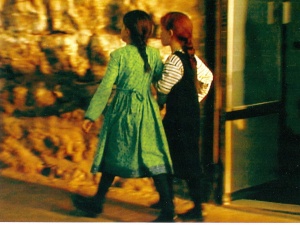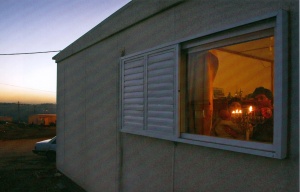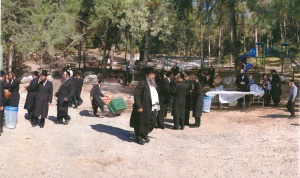Dateline: Israel at the Jewish Museum
Photography is a tantalizingly young medium that burst upon the visual scene with the spectacular daguerreotype invented in France in 1839. Its use and popularity quickly spread from Europe to the Middle East so much so that an early commentator on photography, Francis Wey, called pictures that document the Orient (Palestine) “peaceful conquests.” An army of images. And indeed one of the primary impulses of photography to this day is the desire to somehow “possess” the object, scene or person photographed. By capturing an instant in time we imagine that we have seized a piece of fleeting reality, trapping it in an exquisite slice of time like an insect in amber.
Dateline Israel currently at the Jewish Museum presumes to do exactly that as it “takes the artistic pulse of Israel by presenting [photographic and video] works by…contemporary artists.” The subjects, exclusively of Israel-based people, landscape and events, promise to “capture an unfolding reality.” Therefore while many of the works shown were created as what we might define as Art Photography, the tone of the entire exhibition is documentary.
As the introduction to the catalogue by photography critic Andy Grundberg makes abundantly clear there is more to photography than the creation of documents. Indeed he delineates four primary ways photographs function as applied to the Land of Israel. The first, as mentioned, is as a kind of possession or colonialization of land and native peoples. Next historically was the use of photography to propagandize a set of ideals, specifically Zionism. Photojournalism weighs in heavily in the documentation process to cement meaning of events and places. Finally photography as art begins to flourish with the Camera Obscura School of Art established in 1978 by Ari Hammer and Michal Rovner in Tel Aviv and the Bezalel Academy’s degree program in photography in 1986. As evidenced by many works in this show, this artistic perspective frequently aims to upset conventional ways of seeing the world in a kind of deconstruction of presumed reality.

The twenty-three artists range over a multitude of themes that can be sub-divided into five general categories; Home, Borders, Land, Conflict and Lives. Natan Dvir (in catalogue only) quietly evokes the struggle in Gush Katif as we see a resident taping the image of an Israeli flag on the window overlooking the sea of the synagogue at Shirat HaYam in May, 2005. Similarly Leora Laor captures the quiet piety of Hassidic life in Wanderland, 2002-4, a series of three photos of young women, children and a man in the golden toned alleys and streets of what appears to be Mea Shearim. A fleeting sense of distance respects the modesty and simplicity of these cloistered lives.

There is perhaps no theme that defines Jewish existence as persuasively as “Borders.” Our lives are ruled by halachic borders as much as the Land of Israel is defined and redefined by physical and psychological borders. The security barrier that divides Palestinian from Israeli is but a fence and security road for most of its proposed 400 mile length. But in Jerusalem it becomes an impenetrable concrete wall. The Palestinian photographer, Noel Jabbour’s Abu Dis Wall, 2004 has created a 9’ wide montage that uses the abstract shape of the wall curving through the hilly land to define a land divided by a two peoples unable to live in peace. As we attempt to get our bearings with the repeated image of a grove of trees on the right and left edge we feel that this image places us simultaneously on both sides of the wall, revealing that borders create reality, and a kind of peace, on both sides.
The centrality of the Land flows from the need and insistence on borders. Yael Bartana’s six minute video Trembling Time, 2001, remains as powerful as when I first reviewed it in July, 2005. Her slow motion view of the Ayalon Highway in Tel Aviv on the eve of Yom Hazikaron for Israel’s fallen soldiers depicts the traffic as it slows to a stop and people get out of their cars. They observe a minute of silence for the human cost of possessing a land that is your own. A kind of perverse mirror image of the land is Yaron Leshem’s Village, 2004 in which an odd ramshackle Arab village nestled in an Israeli landscape is slowly revealed as a mock village constructed by the Israeli army for combat training. In contemporary Israel few things are exactly what they seem.
Perhaps as part of this uncertainty over the exact nature of our land Jerusalem Seen from the Mount of Olives, 2000 by Wim Wenders presents a particularly acerbic view. This photograph is a vertical panorama that starts with a grove of olive trees littered with rubbish and broken appliances at the bottom and extends its upward gaze to the Temple Mount and the Al Aqsa Mosque. Hardly the scene of holiness we would expect. In an equally upsetting image Sharon Ya’ari depicts in Cypresses, 2001 four straggly trees looking rather abandoned at the edge of a ditch. The exposed earth consists of three distinct horizontal layers of soil and one white plastic pipe that bespeaks neither healthy nature nor the timelessness of the land of our inheritance.

The fact that the Land of Israel provokes conflict is age-old but these photographers reinvent the terms of the struggle. Pavel Wolberg’s image, Jenin, 2004 (catalogue only) is an acidic commentary on the intractable struggle between Palestinian and Israeli, showing two men trudging down a road behind an Israeli tank. They seem to be carrying either their possessions or things to sell, but the detail that snaps the image together is the model of the Al Aqsa Mosque poised on one of their heads. The frequent futility of military might against religious/nationalist passion stands out in gruesome relief. Riva Castelnuovo’s work shows yet another and more familiar aspect of that struggle in Migron Outpost, West Bank, Hanukkah 2004. We are looking into a simple house on a bleak evening. A family; husband, wife and infant, are lighting the menorah for the third night of Hanukah, their light illuminating the inside of the house and more than matching the quickly fading daylight. Their faith in freedom to live in their land bespeaks contemporary courage and determination.
Rineke Dijkstra’s images of Abigail, Herzliya, Israel, April 10, 1999 and Abigail, Palmahim Israeli Air Force Base, December 18, 2000 are two photos that produce a portrait of a young woman taken 20 months apart tracing the transition between civilian life and military life. The distance this individual has traveled is awesome, marking in the most tangible manner the distance between innocence and adulthood. These serial images, one of many that Dijkstra has done that effectively create the genre of the narrative portrait; begin to delineate how far we have traveled from the innocence of Diaspora to the responsibility of nationhood. We now know the gravity of having blood on our hands.

When all is said and done we see that the vast majority of these images are considerably more than simple documents. Each image summons complex meanings because we cannot help but situate the image in the complexity of Israeli and Jewish contemporary society. Barry Frydlender’s images are even more extreme since they are painstakingly pieced together from many different digital pieces, all shot at the same location over the course of several hours. He essentially creates a reality that never existed. Blessing is an enormous work, approximately 5’ by 14’, taken on Lag B’Omer, 2005. This is a totally artificial image of a celebration that was about to happen. We are therefore suspended not in a slice of actual time but rather a compression of time. These individuals never inhabited this image. Frydlenders’s work resists a clear narrative interpretation since each group of Hasidim is to some degree autonomous as a cluster of social relationships. And yet here and there individuals break away; one boy stands alone in the left foreground as an older Hasid strides in his direction. The interaction between old and young breaks the normally rigid groupings of men by age we might expect. It is as if the assembled individuals are in some fundamental waiting for something to happen, and, since we know the image is artificial, we know will never occur.
Dateline Israel is an excellent and thought provoking exhibition of contemporary Israel-based photography and video that shows the enormous strength and creativity of this medium in Israeli art. It does not capture an emerging reality in a documentary way, rather with each new image questions the very notions of a concrete reality. The exhibition leaves us with a profound disquiet and distrust of images as slices of life. Photographs become suspect as facts but profoundly valuable as tools to reassess what we thought we knew.